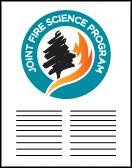United States Joint Fire Science Program
Document Type
Article
Date of this Version
2009
Citation
Final Report for Joint Fire Science Program, Project 05-2-1-13
Abstract
Fine fuels created by non-native annual grasses are a land management problem throughout the United States and beyond. These fuels facilitate the ignition of wildfires and promote their spread, creating hazardous fuel conditions in wildland urban interface areas. For example, fine fuel accumulations from non-native annual grasses in the riparian corridor at Zion National Park threaten the few egress routes from Zion Canyon, creating a threat to human life should a large wildfire occur there. In addition, when these non-native plants create novel fuel characteristics and fire behavior, they can lead to altered fire regimes that can significantly degrade natural resources. Native riparian plant communities in Zion Canyon have already been degraded by non-native plants, and recurrent fire caused by annual grasses could further reduce native plant diversity. There are very few success stories documenting effective control methods for fuelbeds created by non-native annual grasses. Among the methods that have been used with variable success rates are direct biomass removal, herbicide treatments, and seeding of less flammable species to compete with and suppress productivity of the non-native annual grasses. In this study we compared biomass removal (burning or mowing applied in fall), herbicide application (imazapic applied at 12 ounces per acre in fall or spring), and seeding of other species (two native shrubs and three perennial grasses applied at 19.5 pounds per acre pure live seed in winter). Results suggest that burning may have a more lasting effect than mowing in reducing fine fuel loads, at least extending the period between repeated maintenance a few years versus the current annual program of mowing in Zion Canyon. When burning is coupled with fall herbicide application, additional control of brome grasses might extend the maintenance interval even further due to the reduction in brome grass densities. The effects of seeding do not seem to be significantly manifested during the initial 3 years of this study, although the ultimate effects might not be obvious for a number of additional years.
Included in
Forest Biology Commons, Forest Management Commons, Natural Resources and Conservation Commons, Natural Resources Management and Policy Commons, Other Environmental Sciences Commons, Other Forestry and Forest Sciences Commons, Sustainability Commons, Wood Science and Pulp, Paper Technology Commons



Comments
US government work.